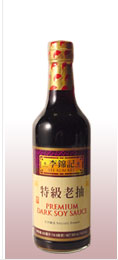Nevertheless, I would like to share with you the essential seasoning or ingredients in chinese cooking (or at least, this are the must-haves in my kitchen). When I first moved out of my parent's house to study in England, these were some of the items that I stock up in the kitchen. Similarly, when my wife and I got married, these are some of the necessities in our kitchen. The list is by no means exhaustive but essential, nevertheless.

Oyster Sauce is a versatile sauce which appears in many chinese recipes. The current brand I am using is Lee Kum Kee's Panda brand Oyster Sauce. You can use it in cooking vegetables and meat recipes. Some even use it as a dip. In some recipes, oyster sauce is probably the only ingredient you need. Whilst it is called oyster sauce, it does not really smell like a bottle of oysters. I would describe the taste as salty sweet.

Next on the list is Light Soya Sauce. Made from fermented soya bean, light soya sauce is a good substitute for salt as it is salty with a hint of sweetness (depending on the quantity of sugar and salt used in the fermentation process). There are many brands available and recently, I had the chance to try out Lee Kum Kee's Premium Soy Sauce above and was quite impressed. It is not overly salty and rather light. This is forgiving because if you are using light soya sauce which is very salty in taste, you might spoil your dish with saltiness if you add a tad too much during cooking.

If you have light soya sauce, you must not forsake the Dark Soya Sauce. Dark soya sauce is of course, darker in colour than its light counterpart but that's not all. Generally, the taste is sweeter than salty though just like light soya sauce, the level of sweetness depends on the manufacturer. I currently use the Kadory brand which is a local brand. It is runny just like the light soya sauce unlike some brands which are thick and slightly sticky. Dark soya sauce is sometimes added to colour the dish and sometimes used as a dip. The picture above is for illustration purposes.
 Next stop, the Shao Hsing rice wine. A must-have in chinese kitchens, it is used in quite a lot of recipes. Besides being a seasoning ingredient (it adds aroma and sweetness to the dish), it is also used as a marinade. There are many brands available in the market and most of them are called Shao Hsing or Tsao Tsing rice wine. Most likely due to its origin in China.
Next stop, the Shao Hsing rice wine. A must-have in chinese kitchens, it is used in quite a lot of recipes. Besides being a seasoning ingredient (it adds aroma and sweetness to the dish), it is also used as a marinade. There are many brands available in the market and most of them are called Shao Hsing or Tsao Tsing rice wine. Most likely due to its origin in China.
Apart from the above, I also have corn flour or corn starch in my kitchen. It is used in marinades (to seal the meat, I think) as well as to mixed with water to form starch to thicken gravies. When used as corn starch, it can give some dishes eg. vegetables a smooth feel when eaten.

If you have checked out some of my recipes, one of my most used items is dried chinese mushrooms. I understand that these are shiitaki mushrooms. It has a smoky flavour and depending on one's taste buds, can be either heavenly or repulsive. Those grown in Japan are the most expensive and I find them fragrant. The good quality ones have nice "flower" patterns on the top of the mushroom. These dried mushrooms are always pre-soaked with water to soften it. If you know you are going to cook them, it is best to pre-soak them overnight to enable the mushrooms to be fully hydrated. That way, they will be able to absorb whatever gravy you are cooking as well as imparting it's own taste to the dish you are cooking.
Apart from the above, other essentials are too obvious to mention eg. salt, sugar, cooking oil and such. I do have monosodium glutamate as well (Ajinomoto) but I rarely use it. It is a taste enhancer and if I do actually use it, I only take a pinch.
By the way, I don't get paid by any of the companies above by writing this post :)
Technorati Tags : Chinese Cooking , Ingredients , Sauce
Labels: Ingredients



